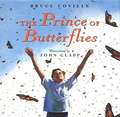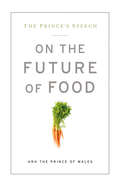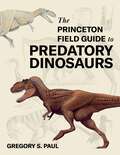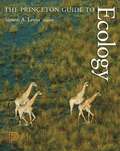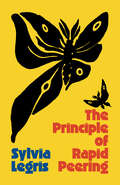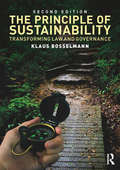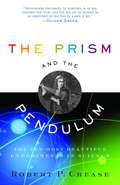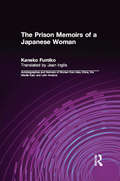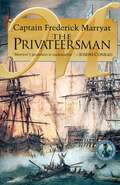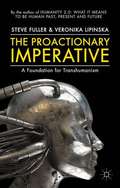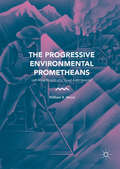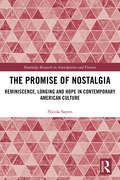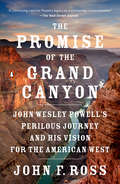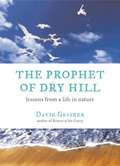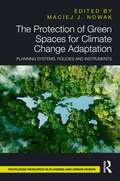- Table View
- List View
The Pride of a Lion: What the Animal Kingdom Can Teach Us About Survival, Fear and Family
by Greg Cote Ron MagillThe Indomitable Spirit of K’wasi the Lion Cub May Forever Change Your Perspective on Life“To millions of people in Miami and beyond, Ron Magill is the face and voice of all things’ wildlife.” ─Mireya Mayor, PhD and National Geographic ExplorerEditors' Pick#1 Best Seller in Biology of Cats, Lions & TigersDiscover the true and incredible survival story of K’wasi, the lion cub who overcame unimaginable odds Magnificently documented by wildlife expert Ron Magill. K’wasi’s story is told by world renowned wildlife photographer and Zoo Miami’s “Goodwill Ambassador”, Ron Magill who documented and photographed every stage of K’wasi’s remarkable roller coaster life. Join Ron and his half-a-century career as he helps us all understand the life lessons the animal kingdom has for us.A survival story of grit and resilience. The story of K’wasi the lion cub is one of heartbreak and triumph. He was born to Asha at Zoo Miami in late 2013 and captured the heart of the nation as an incredibly cute lion cub. K’wasi was orphaned in March 2014 when his mother tragically died. K’wasi’s remarkable journey takes him from the untimely death of his mother to magnificent star of Lion Country Safari.Animals have feelings too. Society has only recently accepted the incredible emotional intelligence of dogs, pigs, and chimpanzees. But through K’wasi’s remarkable story, Ron Magill details how evolved the animal kingdom truly is—lions in particular. Funny, engaging, touching, and thrilling, The Pride of a Lion teaches us about family, resilience, and the meaning of life.Inside find:Gripping accounts of K'wasi's triumphs against extreme adversityRon Magill's stunning wildlife photography capturing K'wasi's remarkable lifeProfound insights into the emotional intelligence and complex social dynamics of the lion kingdomA fan of The Lion King, or liked The Lion Tracker’s Guide to Life, The Soul of an Octopus, or The Good Good Pig? Then you'll love The Pride of a Lion.
The Primal Feast: Food, Sex, Foraging, and Love
by Susan AllportFood makes the world go around, according to this absorbing account of how the search for food has shaped human nature. It is more important than love or sex for the simple reason that food is harder to find than a mate. Think of it this way, says Allport, who draws on the research of anthropologists and biologists in presenting her fascinating and provocative theories: Mates are often willing accomplices in the act of mating; food is never a willing accomplice in the act of eating.
The Primal Place
by Robert FinchFrom acclaimed author and naturalist Robert Finch, a richly detailed observance of Cape Cod's seemingly vanished natural and human past, as it clings to its present landscape. This is a voyage of discovery, a personal odyssey into the nature of a single Cape Cod neighborhood. It is a rich portrait, beautifully drawn, of a landscape and a community whose essential character lies in their penetrating interface with the sea. But it is also an individual quest, a journey of the heart and mind in which the author seeks "entrance, or rather re-entrance" into "that vast living maze stretching out beyond my lines of sight."
The Prince in the Heather
by Eric LinklaterThis is an account, by a world-famous Scottish author, of the greatest manhunt in history. The time is August, 1746: the quarry none other than Bonnie Prince Charlie, fleeing for his life after the disastrous battle of Culloden, the last pitched battle to be fought on British soil. The story, told almost day by day and using journals and other contemporary sources, is one of superb bravery, cold treachery, desperate moonlight escapes, hiding out in caves and pig-styes with the most meagre of supplies, and of the love and devotion of a few faithful Highlanders who gladly offered up their lives for the Prince from over the water. Here is the most spell-binding book about Scotland ever published. It is fact filled and suspenseful but always interesting. Here is Bonnie Prince Charlie at his best, braving deprivation, foul weather, and long marches in bare feet. He relies on help from the poorest to the most aristocratic Scotsmen. Dressed in sodden rags or disguised as a serving man, even a servant woman, his wit, highest nobility, Christian faith, innate kindness and ability to inspire and charm, remain in tact. This is Scotland at its wild, proud, best.
The Prince of Butterflies
by Bruce CovilleOne summer morning, a flock of butterflies alights on John Farrington's house and changes his life forever. Surrounding John in his yard, the monarchs ask for his help. They have lost their way. The green places are gone--the meadows have become mini-malls; the forests are now parking lots. Can John lead them to another refuge? Passionate, moving, and inspiring, this glorious flight of fantasy from master storyteller Bruce Coville is a timely fable about the difficulties--and the rewards--of staying true to one’s heart.
The Prince's Speech: On The Future Of Food
by HRH The Prince of WalesThe Prince's Speech is a stirring, thought-provoking, and ultimately hopeful call to action from one of the world's leading proponents of sustainable farming practices, His Royal Highness the Prince of Wales.
The Princeton Field Guide to Dinosaurs
by Gregory S. PaulThis lavishly illustrated volume is the first authoritative dinosaur book in the style of a field guide. World-renowned dinosaur illustrator and researcher Gregory Paul provides comprehensive visual and textual coverage of the great Mesozoic animals that gave rise to the living dinosaurs, the birds. Incorporating the new discoveries and research that are radically transforming what we know about dinosaurs, this book is distinguished both by its scientific accuracy and the quality and quantity of its illustrations. It presents thorough descriptions of more than 735 dinosaur species and features more than 600 color and black-and-white images, including unique skeletal drawings, "life" studies, and scenic views--illustrations that depict the full range of dinosaurs, from small, feathered creatures to whale-sized supersauropods. Heavily illustrated species accounts of the major dinosaur groups are preceded by an extensive introduction that covers dinosaur history and biology, the extinction of nonavian dinosaurs, the origin of birds, and the history of dinosaur paleontology--and that also gives a taste of what it might be like to travel back to the time of the dinosaurs. The Princeton Field Guide to Dinosaursis a must-have for anyone who loves dinosaurs, from the amateur enthusiast to the professional paleontologist. The first authoritative field guide to dinosaurs Covers more than 735 species Beautiful, large-format volume Lavishly illustrated throughout, with more than 600 color and black-and-white drawings and figures, including: More than 130 color life studies, including scenic views Close to 450 skeletal, skull, head, and muscle drawings 8 color paleo-distribution maps Color timeline Describes anatomy, physiology, locomotion, reproduction, and growth of dinosaurs, as well as the origin of birds and the extinction of nonavian dinosaurs
The Princeton Field Guide to Predatory Dinosaurs (Princeton Field Guides)
by Gregory S. PaulAn authoritative illustrated guide to the fearsome predators that dominated the Mesozoic world for 180 million yearsNew discoveries are transforming our understanding of the theropod dinosaurs, revealing startling new insights into the lives and look of these awesome predators. The Princeton Field Guide to Predatory Dinosaurs provides the most up-to-date and comprehensive coverage of the mighty hunters that ruled the earth for tens of millions of years. This incredible guide covers some 300 species and features stunning illustrations of predatory theropods of all shapes and sizes. It discusses their history, anatomy, physiology, locomotion, reproduction, growth, and extinction, and even gives a taste of what it might be like to travel back to the Mesozoic. This one-of-a-kind guide also discusses the controversies surrounding these marvelous creatures, taking up such open questions as the form and habitats of the gigantic Spinosaurus and the number of Tyrannosaurus species that may have existed.Features detailed species accounts of some 300 theropod dinosaurs, with the latest size and mass estimatesShares new perspectives on iconic predators such as T. rex and VelociraptorCovers everything from the biology of predatory dinosaurs to the colorful history of paleontologyFeatures a wealth of color and black-and-white drawings and figures, including life studies, scenic views, and original skeletal, skull, and muscle reconstructionsIncludes detailed color maps
The Princeton Guide to Ecology
by Simon A. LevinThe Princeton Guide to Ecology is a concise, authoritative one-volume reference to the field's major subjects and key concepts. Edited by eminent ecologist Simon Levin, with contributions from an international team of leading ecologists, the book contains more than ninety clear, accurate, and up-to-date articles on the most important topics within seven major areas: autecology, population ecology, communities and ecosystems, landscapes and the biosphere, conservation biology, ecosystem services, and biosphere management. Complete with more than 200 illustrations (including sixteen pages in color), a glossary of key terms, a chronology of milestones in the field, suggestions for further reading on each topic, and an index, this is an essential volume for undergraduate and graduate students, research ecologists, scientists in related fields, policymakers, and anyone else with a serious interest in ecology. Explains key topics in one concise and authoritative volume Features more than ninety articles written by an international team of leading ecologists Contains more than 200 illustrations, including sixteen pages in color Includes glossary, chronology, suggestions for further reading, and index Covers autecology, population ecology, communities and ecosystems, landscapes and the biosphere, conservation biology, ecosystem services, and biosphere management
The Principle of Rapid Peering
by Sylvia LegrisA lyrical guide through Saskatchewan’s Aspen Parkland by a poet whose work is “fizzing with ecological intellect” (Times Literary Supplement). Self-seeding wind is a wind of ever-replenishing breath. —from “The Walk, or The Principle of Rapid Peering” The title of Sylvia Legris’ melopoeic collection The Principle of Rapid Peering comes from a phrase the nineteenth-century ornithologist and field biologist Joseph Grinnell used to describe the feeding behavior of certain birds. Rather than waiting passively for food to approach them, these birds live in a continuous mode of “rapid peering.” Legris explores this rich theme of active observation through a spray of poems that together form a kind of almanac or naturalist’s notebook in verse. Here is “where nature converges with words,” as the poet walks through prairie habitats near her home in Saskatchewan, through lawless chronologies and mellifluous strophes of strobili and solstice. Moths appear frequently, as do birds and plants and larvae, all meticulously observed and documented with an oblique sense of the pandemic marking the seasons. Elements of weather, ornithology, entomology, and anatomy feed her condensed, inflective lines, making the heart bloom and the intellect dance.
The Principle of Sustainability: Transforming law and governance
by Klaus BosselmannThis book investigates how sustainability informs key principles and concepts of domestic and international law. It calls for the recognition of ecological sustainability as a fundamental principle to guide the entire legal system rather than just environmental legislation. To this end, the book makes a contribution to global environmental constitutionalism, a rapidly growing area within comparative and international environmental law and constitutional law. This 2nd edition has been fully revised and updated to take account of recent developments and new case law. The book will be a valuable resource for students, researchers and policy makers working in the areas of environmental law and governance.
The Prism and the Pendulum
by Robert CreaseIs science beautiful? Yes, argues acclaimed philosopher and historian of science Robert P. Crease in this engaging exploration of history's most beautiful experiments. The result is an engrossing journey through nearly 2,500 years of scientific innovation. Along the way, we encounter glimpses into the personalities and creative thinking of some of the field's most interesting figures.We see the first measurement of the earth's circumference, accomplished in the third century B.C. by Eratosthenes using sticks, shadows, and simple geometry. We visit Foucault's mesmerizing pendulum, a cannonball suspended from the dome of the Panthéon in Paris that allows us to see the rotation of the earth on its axis. We meet Galileo--the only scientist with two experiments in the top ten--brilliantly drawing on his musical training to measure the speed of falling bodies. And we travel to the quantum world, in the most beautiful experiment of all.We also learn why these ten experiments exert such a powerful hold on our imaginations. From the ancient world to cutting-edge physics, these ten exhilarating moments reveal something fundamental about the world, pulling us out of confusion and revealing nature's elegance. The Prism and the Pendulum brings us face-to-face with the wonder of science.From the Hardcover edition.
The Prism and the Pendulum: The Ten Most Beautiful Experiments in Science
by Robert CreaseIs science beautiful? Yes, argues acclaimed philosopher and historian of science Robert P. Crease in this engaging exploration of history's most beautiful experiments. The result is an engrossing journey through nearly 2,500 years of scientific innovation. Along the way, we encounter glimpses into the personalities and creative thinking of some of the field's most interesting figures.We see the first measurement of the earth's circumference, accomplished in the third century B.C. by Eratosthenes using sticks, shadows, and simple geometry. We visit Foucault's mesmerizing pendulum, a cannonball suspended from the dome of the Panthéon in Paris that allows us to see the rotation of the earth on its axis. We meet Galileo--the only scientist with two experiments in the top ten--brilliantly drawing on his musical training to measure the speed of falling bodies. And we travel to the quantum world, in the most beautiful experiment of all.We also learn why these ten experiments exert such a powerful hold on our imaginations. From the ancient world to cutting-edge physics, these ten exhilarating moments reveal something fundamental about the world, pulling us out of confusion and revealing nature's elegance. The Prism and the Pendulum brings us face-to-face with the wonder of science.From the Hardcover edition.
The Prison Memoirs of a Japanese Woman
by Mikiso Hane Kaneko Fumiko Jean InglisKaneko Fumiko (1903-1926) wrote this memoir while in prison after being convicted of plotting to assassinate the Japanese emperor. Despite an early life of misery, deprivation, and hardship, she grew up to be a strong and independent young woman. When she moved to Tokyo in 1920, she gravitated to left-wing groups and eventually joined with the Korean nihilist Pak Yeol to form a two-person nihilist organization. Two days after the Great Tokyo Earthquake, in a general wave of anti-leftist and anti-Korean hysteria, the authorities arrested the pair and charged them with high treason. Defiant to the end (she hanged herself in prison on July 23, 1926), Kaneko Fumiko wrote this memoir as an indictment of the society that oppressed her, the family that abused and neglected her, and the imperial system that drove her to her death.
The Prison Memoirs of a Japanese Woman
by Mikiso Hane Kaneko Fumiko Jean InglisKaneko Fumiko (1903-1926) wrote this memoir while in prison after being convicted of plotting to assassinate the Japanese emperor. Despite an early life of misery, deprivation, and hardship, she grew up to be a strong and independent young woman. When she moved to Tokyo in 1920, she gravitated to left-wing groups and eventually joined with the Korean nihilist Pak Yeol to form a two-person nihilist organization. Two days after the Great Tokyo Earthquake, in a general wave of anti-leftist and anti-Korean hysteria, the authorities arrested the pair and charged them with high treason. Defiant to the end (she hanged herself in prison on July 23, 1926), Kaneko Fumiko wrote this memoir as an indictment of the society that oppressed her, the family that abused and neglected her, and the imperial system that drove her to her death.
The Private Lives of Public Birds: Learning to Listen to the Birds Where We Live
by Jack GedneyA book to help the ordinary birdwatcher appreciate the fascinating songs, stories, and science of common birds Jack Gedney’s studies of birds provide resonant, affirming answers to the questions: Who is this bird? In what way is it beautiful? Why does it matter? Masterfully linking an abundance of poetic references with up-to-date biological science, Gedney shares his devotion to everyday Western birds in fifteen essays. Each essay illuminates the life of a single species and its relationship to humans, and how these species can help us understand birds in general. A dedicated birdwatcher and teacher, Gedney finds wonder not only in the speed and glistening beauty of the Anna’s hummingbird, but also in her nest building. He acclaims the turkey vulture’s and red-tailed hawk’s roles in our ecosystem, and he venerates the inimitable California scrub jay’s work planting acorns. Knowing that we hear birds much more often than we see them, Gedney offers his expert’s ear to help us not only identify bird songs and calls but also understand what the birds are saying. The crowd at the suet feeder will never look quite the same again. Join Gedney in the enchanted world of these not-so-ordinary birds, each enlivened by a hand-drawn portrait by artist Anna Kus Park.
The Privateersman
by Capt. Frederick MarryatPrivateers were essentially freelance ships, sanctioned during wartime to sail and do battle on behalf of adversary governments. This tale follows Alexander Musgrave, a privateer-turned-adventurer, across three continents and into the arms of a beautiful woman.
The Proactionary Imperative
by Steve FullerThe Proactionary Imperative debates the concept of transforming human nature, including such thorny topics as humanity's privilege as a species, our capacity to 'play God', the idea that we might treat our genes as a capital investment, eugenics and what it might mean to be 'human' in the context of risky scientific and technological interventions.
The Professional Photographer's Guide to Shooting & Selling Nature & Wildlife Photos
by Jim ZuckermanWildlife and nature can be close to you as your backyard or the nearest zoo. In The Professional Photographer's Guide to Shooting & Selling Nature & Wildlife Photos, a professional photographer shows how to take fabulous wildlife and nature photographs and how to reach the best markets. More than 250 full-color photos include captions with detailed explanations of where and how each was shot and the easiest way to achieve the same effect.
The Progress of This Storm: Nature and Society in a Warming World
by Andreas MalmAn attack on the idea that nature and society are impossible to distinguish from each otherIn a world careening towards climate chaos, nature is dead. It can no longer be separated from society. Everything is a blur of hybrids, where humans possess no exceptional agency to set them apart from dead matter. But is it really so? In this blistering polemic and theoretical manifesto, Andreas Malm develops a counterargument: in a warming world, nature comes roaring back, and it is more important than ever to distinguish between the natural and the social. Only with a unique agency attributed to humans can resistance become conceivable.
The Progressive Environmental Prometheans
by William B. MeyerThis book is devoted to the exploration of environmental Prometheanism, the belief that human beings can and should master nature and remake it for the better. Meyer considers, among others, the question of why Prometheanism today is usually found on the political right while environmentalism is on the left. Chapters examine the works of leading Promethean thinkers of nineteenth and early and mid-twentieth century Britain, France, America, and Russia and how they tied their beliefs about the earth to a progressive, left-wing politics. Meyer reconstructs the logic of this "progressive Prometheanism" and the reasons it has vanished from the intellectual scene today. The Progressive Environmental Prometheans broadens the reader's understanding of the history of the ideas behind Prometheanism. This book appeals to anyone with an interest in environmental politics, environmental history, global history, geography and Anthropocene studies.
The Promise of Nostalgia: Reminiscence, Longing and Hope in Contemporary American Culture (Routledge Research in Anticipation and Futures)
by Nicola SayersThe Promise of Nostalgia analyses a range of texts – including The Virgin Suicides, both the novel by Jeffrey Eugenides’ and Sofia Coppola’s screen adaptation, photography of Detroit’s ‘abandoned spaces’, and blogger Tavi Gevinson's media output – to explore nostalgia as a prominent affect in contemporary American cultural production. Counter to the prevalent caricature of nostalgia as anti-future, the book proposes a more nuanced reading of its stakes and meanings. Instead of understanding it as evidence of the absence of utopia it contends that there is a masked utopian impulse in this nostalgia ‘mode’ and critical potential in what has typically been dismissed as ideological. This book will be of interest to scholars, graduate students and upper-level undergraduate students interested in contemporary culture, cultural theory, media studies, the Frankfurt School, utopian studies and American literature and culture.
The Promise of the Grand Canyon: John Wesley Powell's Perilous Journey and His Vision for the American West
by John F. RossA timely, thrilling account of a man who, as an explorer, dared to lead the first successful expedition down the Colorado through the Grand Canyon--and, as an American visionary, waged a bitterly-contested campaign for environmental sustainability in the American West.When John Wesley Powell became the first person to navigate the entire Colorado River, through the Grand Canyon, he completed what Lewis and Clark had begun nearly 70 years earlier--the final exploration of continental America. The son of an abolitionist preacher, a Civil War hero (who lost an arm at Shiloh), and a passionate naturalist and geologist, in 1869 Powell tackled the vast and dangerous gorge carved by the Colorado River and known today (thanks to Powell) as the Grand Canyon. With The Promise of the Grand Canyon, John Ross recreates Powell's expedition in all its glory and terror, but his second (unheralded) career as a scientist, bureaucrat, and land-management pioneer concerns us today. Powell was the first to ask: how should the development of the west be shaped? How much could the land support? What was the role of the government and private industry in all of this? He began a national conversation about sustainable development when most everyone else still looked upon land as an inexhaustible resource. Though he supported irrigation and dams, his prescient warnings forecast the 1930s dustbowl and the growing water scarcities of today. Practical, yet visionary, Powell didn't have all the answers, but was first to ask the right questions.
The Prophet of Dry Hill: Lessons from a Life in Nature
by David GessnerThis book is the compelling story of two men and the year they spent together. But more than a book about friendship, it's a lyrical primer on the importance of living a life connected to the wild. John Hay has lived deeply on one piece of land for sixty years. As a consequence, he has much to tell Gessner-and us-about the importance of creating a strong relationship with the land we live on. His words speak to our forgotten need for space and for reaching beyond ourselves to the world outside. Seeing is the great discipline that nature teaches, Hay proclaims. Nature, not psychology, is the path to our true selves.
The Protection of Green Spaces for Climate Change Adaptation: Planning Systems, Policies and Instruments (Routledge Research in Planning and Urban Design)
by Maciej J. NowakThe Protection of Green Spaces for Climate Change Adaptation identifies how spatial planning and climate change adaptation are linked by examining the protection of green spaces in cities across Europe, Africa, the Middle East, South America and Australia.This book identifies how, in each case, spatial planning instruments can influence the protection of green spaces, and whether – and if so how – they are being adapted in response to actual and expected effects from climate change. In doing so, the institutional frameworks of each country analysed are first presented. This provides the basis for discussing the key problems occurring at the state (and city) level in responding to the challenges of climate change adaptation, especially for the protection of green spaces. In the individual chapters, the issues identified above will be analysed from the perspective of diverse countries: Australia, Ghana, Iran, Mexico, Brazil and Poland. The contributors in this edited collection will present how the indicated issue is identified in systems that are diverse in many respects. This book concludes by demonstrating how the relationship between climate change adaptation and spatial planning can be framed in a more universal way, taking into account the international case studies that have been presented. This book deals extensively with both climate change adaptation issues and comparisons of spatial planning systems.By focusing on a synthesis of these issues, this book will add significantly to the discussion, providing a new basis for theoretical and practical considerations. It will be of interest to researchers and students of spatial planning, public policy, environmental protection, climate protection and law, as well as professionals working in these areas.




